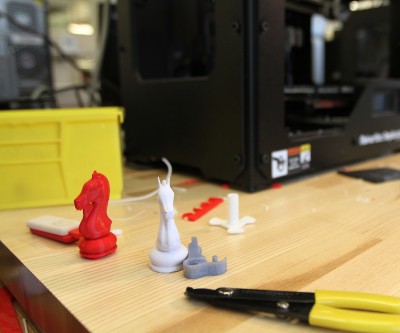
The 3-D printing phenomenon, though not new, is breaking free from its industry niche.
For the most part, this technology has remained constricted to the engineering fields, used to create models and parts. As the machines become cheaper to manufacture and more widely disseminated, they are being used in new fields.
FormLabs, a 3-D printing firm that got its start at the Massachusetts Institute of Technology in 2011, experienced first-hand one of the new applications for 3-D printing technology.
Meghan Maupin, an instructional designer at FormLabs, explained that the traditional use for 3-D printers is really in, as one would think, engineering. Upon being approached by artist and filmmaker Gilles-Alexandre Deschaud, though, they were intrigued. Deschaud’s new project “Chase Me,” is a stop-motion film made using entirely 3-D printed parts.
“Eventually, he came to tell us more about how he was printing day and night on this project, and he sent us the trailer,” Maupin said.
When they saw the project he was working on, Maupin and her colleagues were impressed.
“We had never seen something so tiny and so delicate printed on our printer,” Maupin said. “We [thought] this looks like an amazing movie, let’s give this guy another printer and materials to help him finish it up.”
Although the Deschaud film was the first to be made entirely using 3-D printed parts, the power of 3-D printing had been harnessed by the film industry before on a smaller scale. In Maupin’s experience, the printers have been used to work on character or production design or to work out ideas.
In terms of new applications for the printer, it doesn’t seem to Maupin that they will necessarily “revolutionize manufacturing,” but rather that it will “cut down the cost of prototyping.”
“[They will] save a lot of money that way,” she said, “and also save a lot of time.”
That affordability, she said, will translate to more access down the road, even for people with no business printing in 3-D.
“I can see maybe in the future people having a 3-D printer in their home, [and] I can see 3-D printing going more mainstream, especially for DIY [do-it-yourself],” Maupin said. “I can see more so of having a 3-D printer at every design school.”
This is not the first technology that began its dissemination in profession settings. Jeffrey Furman, a professor in the Questrom School of Business, pointed out that “initially there was widespread doubt about whether personal computers would ever be used,” but they have now been adopted as a prevalent form of personal technology. In order for 3-D printers to be embraced in households, Furman said a few critical steps would have to occur.
“Very often, these sorts of products go first through beat adopters, who are a little bit fanatical about them, and then diffuse to those who are less expert about them,” Furman said.
This diffusion would require additional qualifications, but it would be an easier transition if 3-D printers prove to serve a specific purpose more efficiently than other technology, and at a better cost.
Even more, Furman said, they would need to offer what he calls “complimentary goods,” or products and services that enhance the consumer’s experience at no extra cost, such as free schematics for certain objects.
“The more complimentary goods there are, the more things that go well with the printer or that the printer can do, the greater the likelihood is that the printer will achieve widespread adoption,” he said.
One thing clear about the future of 3-D printers, though, is their potential to change whatever industry they enter.
“This is just the tip of the iceberg for purposes of 3-D printing. The possibilities are limitless,” said Chris Cavalieri, a professor in the College of Communication’s department of film and television. “As with all new technology, the engineers design it with certain applications in mind, but it’s the creators like Gilles-Alexandre Deschaud that expand the technology’s usefulness.”


